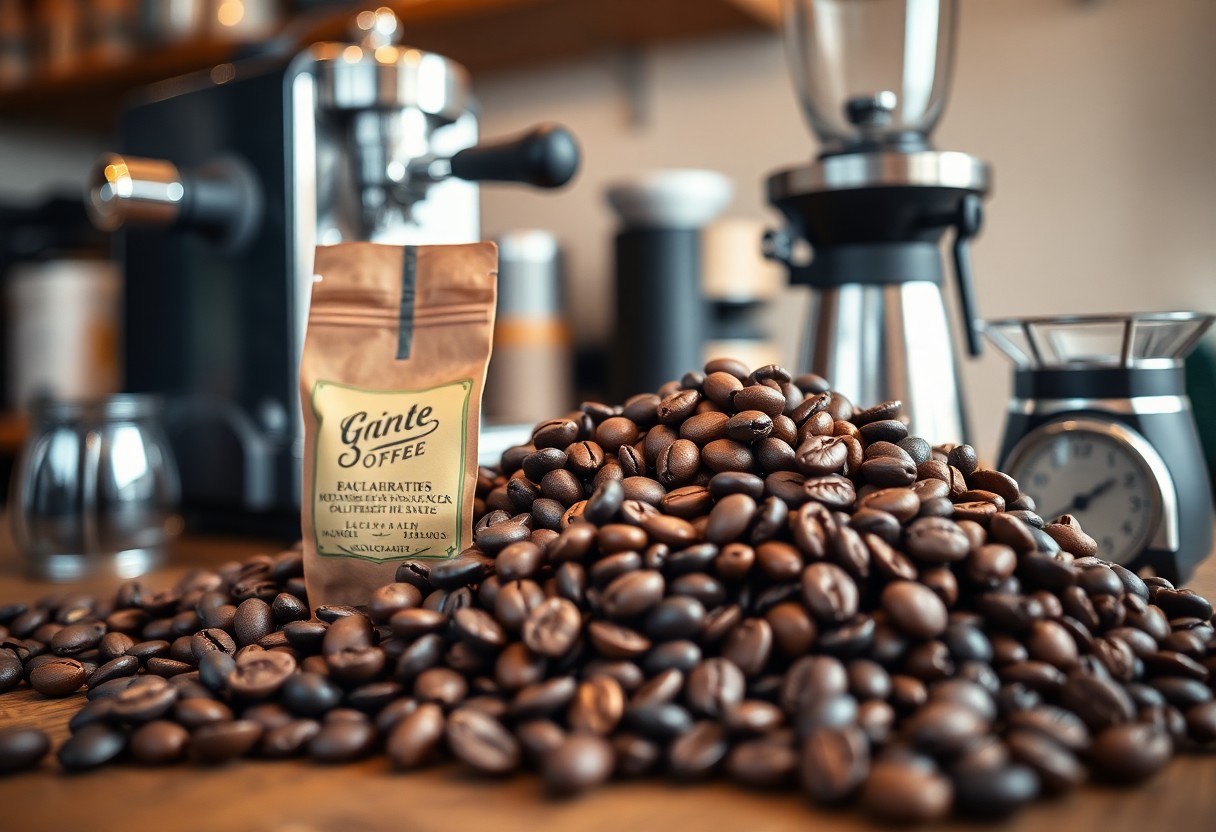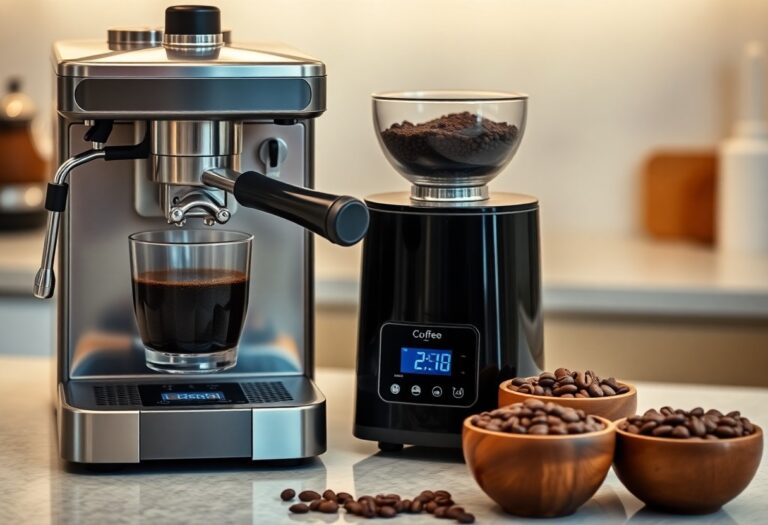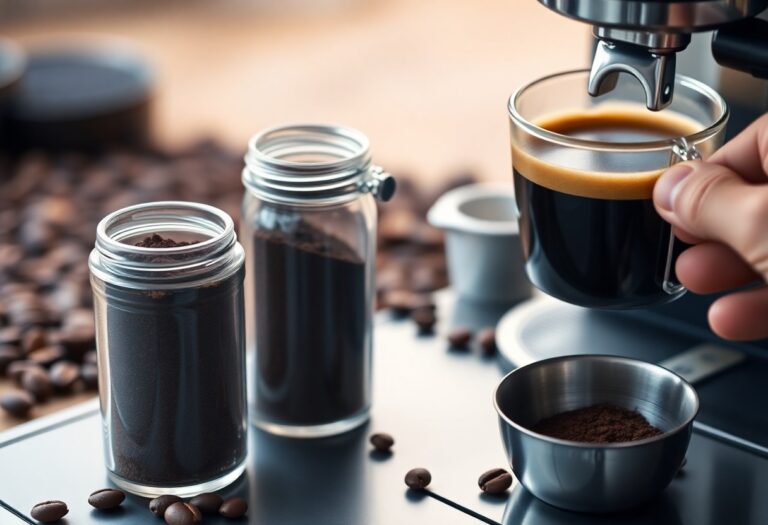What Coffee Should I Buy for My Espresso Machine – Purchase Guide
You might be wondering what kind of coffee beans will elevate your home espresso experience. Choosing the right coffee is imperative for achieving rich flavors and aromatic profiles that complement your machine. In this guide, you will discover how to select beans that suit your taste preferences, grinding techniques that maximize extraction, and tips on selecting blends that enhance your espresso’s quality. By understanding these elements, you can ensure that each cup you brew from your espresso machine is both delicious and satisfying.
Key Takeaways:
- Look for coffee beans specifically labeled as espresso to ensure a balanced flavor and optimal extraction.
- Consider the roast level; medium to dark roasts tend to produce richer, bolder flavors ideal for espresso.
- Pay attention to the grind size; espresso requires a fine grind for proper extraction and crema formation.
- Explore single-origin beans for unique flavors or blends for a more complex taste profile.
- Always check the freshness of the coffee; freshly roasted beans yield the best flavor and aroma for espresso.
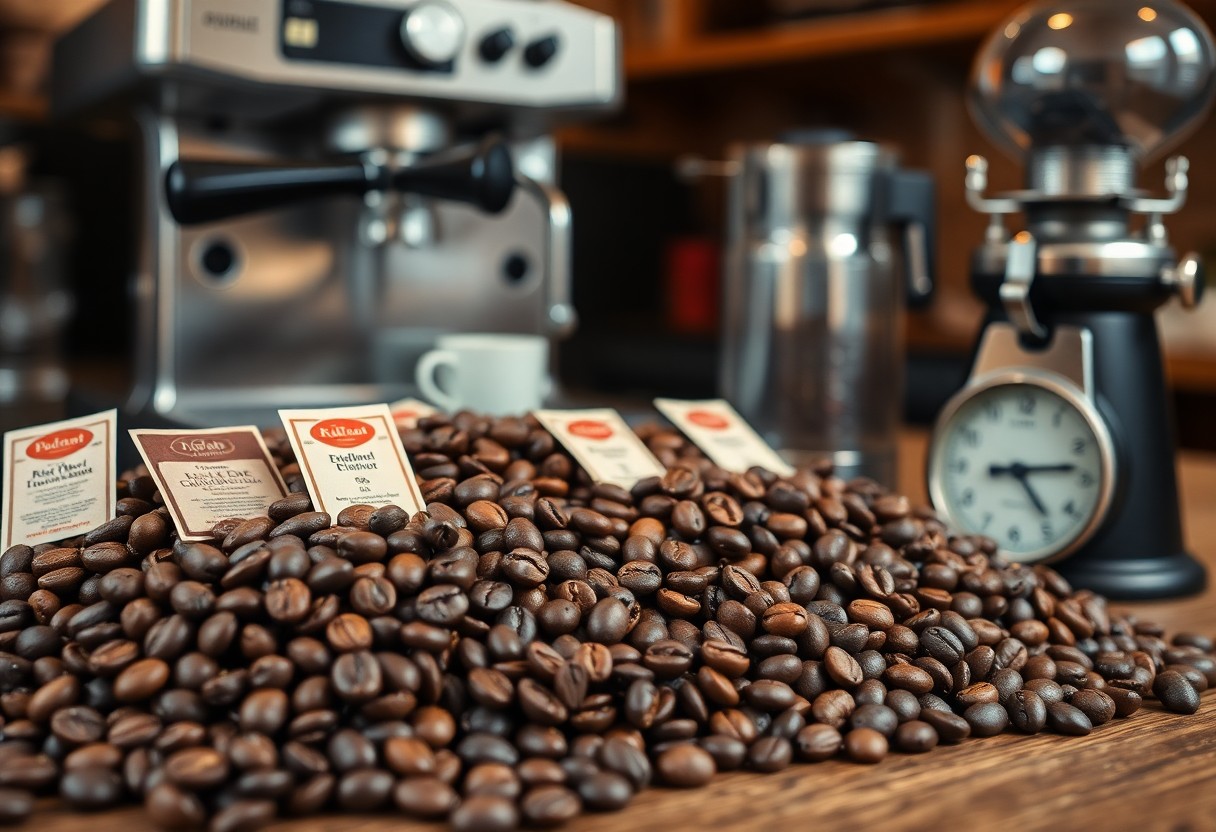
Decoding Flavor Profiles: What to Look for in Coffee Beans
Understanding flavor profiles is important when selecting coffee for your espresso machine. You’ll want to seek out beans that exhibit distinctive notes such as fruity, nutty, or chocolatey, depending on your taste preferences. Aromas play an equally significant role; a rich, complex scent can elevate your espresso experience. Investigate beans that carry a balanced acidity and a pleasant body, as these factors can greatly influence the overall taste and mouthfeel of your espresso shot.
The Role of Origin: How Geography Affects Taste
The geographical origin of coffee beans significantly influences their flavor characteristics. For instance, beans from Ethiopia are often known for their bright acidity and floral notes, while Brazilian beans typically feature a more chocolatey and nutty profile. The altitude, climate, and soil conditions from which the coffee is grown contribute to the unique taste of each origin. Understanding these nuances allows you to choose beans that align with your flavor preferences, enhancing your espresso experience.
Roast Levels and Their Impact on Espresso Quality
Roast levels greatly affect the flavor, aroma, and overall quality of your espresso. Light roasts preserve more of the bean’s natural acidity and fruity notes, making them ideal for those who appreciate a vibrant cup. Medium roasts cultivate a balance between brightness and body, while darker roasts bring forth bold flavors with reduced acidity, providing a more robust experience. The choice of roast level can tailor your espresso to meet your unique palate, impacting how the subtle complexities of each bean are expressed in your cup.
When considering roast levels, think about how they interact with your brewing process. A light roast may require precise extraction times to avoid over-extraction, highlighting its delicate flavors. In contrast, a dark roast can often handle longer extraction times, yielding a fuller-bodied shot. Experimenting with various roast levels allows you to discover the ideal profile that resonates with your taste, elevating the pleasures of homemade espresso.
The Espresso Grind: Unlocking the Perfect Consistency
The grind size of your coffee beans significantly impacts the extraction process and flavor profile of your espresso. Achieving the ideal consistency is vital, as it allows water to flow through the coffee evenly, ensuring balanced flavors and a satisfying crema. Your espresso machine’s optimal performance is only realized when you master the grind, making it a key factor in your coffee journey.
All About Grind Size: Finer is Not Always Better
Grind size can often be misleading; while finer grounds are typically associated with espresso, over-extraction can occur if they’re too fine. The correct grind size facilitates a quick and even extraction, ideally around the consistency of table salt. If you grind too finely, you may end up with a bitter espresso that lacks character—a common pitfall for home baristas.
Freshness Matters: The Importance of Grinding Just Before Brewing
Grinding your coffee just before brewing maximizes the freshness and flavor of your espresso. Coffee beans start losing their flavor within minutes of being ground due to oxidation. This loss can significantly diminish the coffee’s aromatic qualities. When you prepare your espresso, aim to grind beans only seconds before brewing for the fullest flavor experience.
Utilizing freshly ground coffee ensures that you retain vital oils and volatile compounds, which are crucial for that rich espresso shot you desire. For instance, specialty coffee can lose up to 60% of its aromatic compounds within 15 minutes of grinding. Investing in a quality burr grinder can also help you achieve consistent grind sizes and elevate your home brewing experience dramatically. Prioritizing freshness makes your espresso not just a drink, but an experience that captures nuance and depth in every sip.
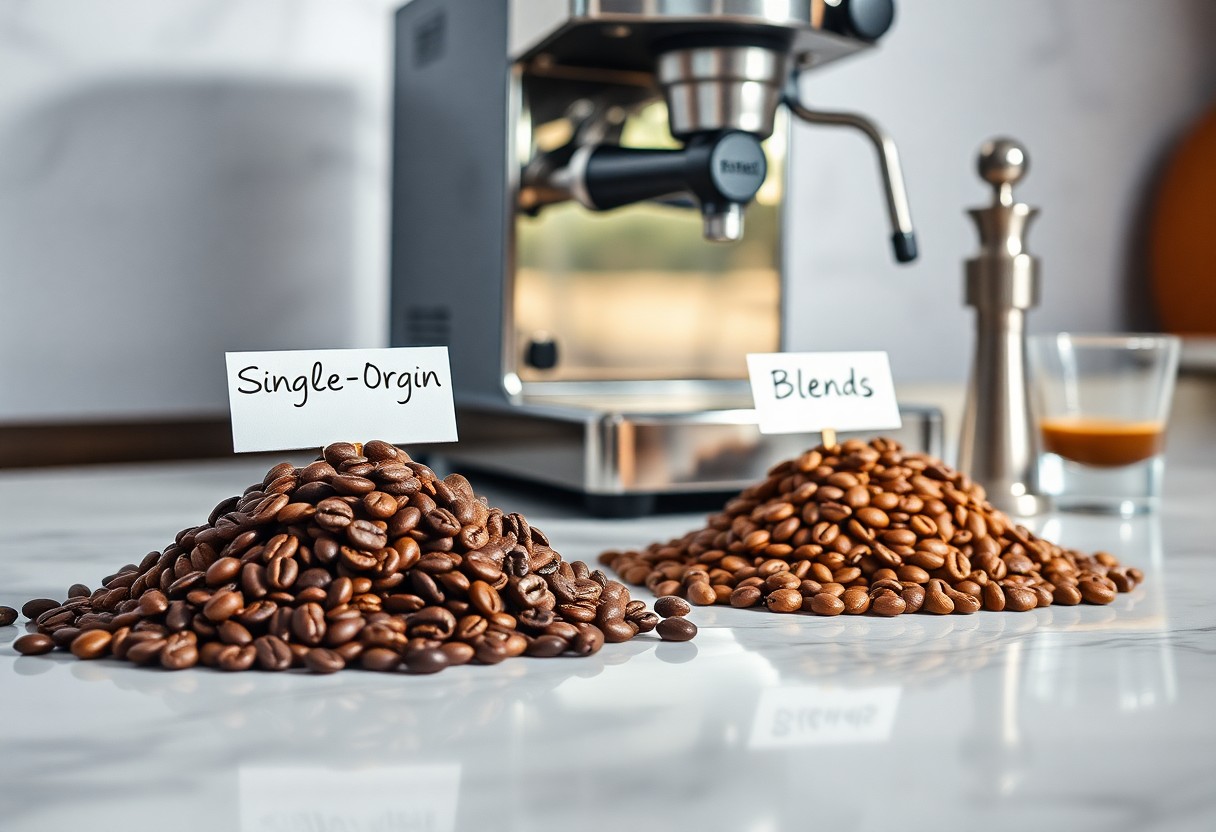
Choosing Between Single-Origin and Blends
Deciding between single-origin coffees and blends can shape your espresso experience significantly. Single-origin coffees come from one specific location, offering a unique taste profile rooted in the region’s climate and soil. In contrast, blends bring together beans from diverse origins, allowing roasters to create balanced flavor profiles and elevate specific notes. Both options have their merits, and your choice should align with your taste preferences and the experience you seek from your espresso machine.
The Allure of Single-Origin Coffees: A Taste Adventure
Single-origin coffees provide a unique opportunity for exploration, as each cup tells the story of its origin. The distinct flavors often reflect the environmental conditions, such as altitude and soil, leading to tasting notes that can range from fruity and floral to chocolatey and nutty. By selecting single-origin options, you’re launching on a taste adventure, savoring the diverse profiles that each region has to offer, like Ethiopian Yirgacheffe’s bright acidity or Sumatra’s earthy depth.
The Art of Blending: Achieving Balance and Complexity
Blends allow roasters to harness the strengths of different beans, creating a complex and harmonious flavor experience. By mixing beans with contrasting flavors, you can achieve a rich balance that highlights sweetness, acidity, and body. For instance, a blend combining a bold Brazilian coffee with a bright Colombian can result in a well-rounded cup that satisfies various palates. This artistry also enables consistency, as blends can help manage variations in single-origin beans due to seasonal changes.
The skill in blending lies in the roaster’s ability to manipulate flavor profiles to suit a particular espresso style or preference. A thoughtfully crafted blend might highlight chocolate notes for a comforting drink or emphasize fruity undertones for a vibrant shot. Masters of blending often experiment with ratios, finding the perfect balance to create a cup that resonates with drinkers. Notably, established brands often offer signature blends that they refine over years, providing you with a reliable choice that consistently delivers a delightful espresso experience.
Ethical Considerations: Sourcing Beans Responsibly
You’re not just choosing coffee beans; you’re making a decision that can impact communities and the environment. Ethical sourcing considers the livelihoods of farmers, the sustainability of the land, and the integrity of the trade practices involved. Engaging with brands that prioritize ethical considerations ensures that the farmers receive fair wages and that coffee production respects both social and environmental standards. When you select ethically sourced coffee, you’re not only enjoying a rich cup but contributing to a fairer, more sustainable world.
Fair Trade and Direct Trade: What They Mean for Your Cup
Fair Trade and Direct Trade are two models focusing on equitable compensation for coffee farmers, significantly affecting the quality and taste of your espresso. Fair Trade certification guarantees that farmers receive a minimum price for their beans, promoting community development and sustainable practices. Direct Trade, on the other hand, involves roasters building direct relationships with farmers, often resulting in higher prices and better-quality beans due to the enhanced focus on sustainability and flavor profiles. By choosing coffee aligned with these models, you support a system that prioritizes quality and ethical responsibility.
Sustainability in Coffee Production: Impact on Flavor and Quality
The sustainability of coffee production plays a vital role in both flavor and quality, shaping the coffee experience you enjoy. Sustainable practices, such as organic farming and biodiversity conservation, contribute to healthier soils and ecosystems that yield richer, more nuanced flavors in your cup. Furthermore, sustainable methods reduce the reliance on harmful chemicals, fostering a more vibrant coffee that reflects its origin authentically. Coffee grown under sustainable conditions tends to result in beans that offer unique taste notes, enhancing your overall espresso experience.
In regions that prioritize sustainability, farmers often use shade-grown methods, which not only preserve local flora and fauna but also allow coffee plants to develop more complex flavors. Studies suggest that coffee beans grown in these environments can carry brighter acidity and deeper sweetness, creating a more satisfying espresso shot. Additionally, when you choose coffee from farms that practice sustainable agriculture, you’re often getting fresher beans due to shorter transportation times and reduced spoilage, ensuring that each cup you brew showcases the true potential of the coffee’s origin.
Practical Steps for Selecting Coffee: From Store to Brew
Navigating the world of coffee can be overwhelming, especially when you’re aiming for that perfect espresso shot. Start by exploring local coffee roasters or specialty stores where you can find freshly roasted beans, ideally marked with a roasting date. Always smell the beans for freshness; a rich, inviting aroma is a good indicator. Selecting a grind that’s suitable for espresso, typically a fine grind, is important. Make sure to consider your brew method, too. Some blends work better in espresso machines than others, so keep an eye out for that as you shop.
Reading Labels: What Each Element Tells You
Focusing on the labels helps decode the coffee’s journey from bean to brew. Look for details like the roast date, origin, and flavor notes. Fresh beans, roasted within two weeks of your purchase, are key to rich flavor. The origin impacts taste; beans from Ethiopia often exhibit fruity notes, while Guatemalan beans lean towards chocolatey tones. Also, take note of the roast level; dark roasts yield a bold flavor, while light roasts carry subtle qualities that highlight the bean’s origin.
Tasting Notes and Reviews: Using Community Wisdom
Utilizing tasting notes and reviews can enhance your coffee selection process. Explore platforms like CoffeeReview or local forums to glean insights from other coffee enthusiasts. Community feedback often highlights specific flavor notes and brewing suggestions, helping you hone in on what’s really delightful and might suit your palate. Pay attention to consistent feedback about acidity, sweetness, and body, which can guide your choices more effectively.
Digging into community reviews offers a wealth of information about specific coffee blends and brands. Engaging with fellow coffee drinkers can introduce you to hidden gems based on personal experiences. For instance, a particular roast may be touted for its caramel notes or bold richness, while others may warn against overly acidic varieties. Taking the time to read what others have enjoyed—or not—can ensure that your purchases deliver satisfaction in every cup, aligning perfectly with your unique taste preferences.
To wrap up
Taking this into account, selecting the right coffee for your espresso machine can elevate your coffee experience significantly. You should consider factors like roast level, bean origin, and grind size to find the perfect match for your taste preferences. For a deeper look into which coffee brands complement your espresso machine, check out Which Popular Coffee Brands Work Best For An Espresso …. Your choice will ultimately determine the richness and flavor of your espresso, so choose wisely!
FAQ
Q: What type of coffee beans are best for espresso?
A: The best type of coffee beans for espresso is generally a dark roast, as it provides a rich, bold flavor and creates a thick crema. Common choices include Arabica and Robusta blends, with Arabica offering sweeter and more nuanced flavors while Robusta brings more body and caffeine. Look for beans labeled specifically for espresso to ensure optimal results.
Q: Should I use whole beans or pre-ground coffee for my espresso machine?
A: Whole beans are always recommended for espresso machines as they preserve the freshness and flavor of the coffee. Grinding the beans just before brewing helps to release the oils and aromas, resulting in a richer and more flavorful espresso shot. If convenience is important, choose pre-ground coffee labeled for espresso, but be aware that it may not be as fresh.
Q: What grind size should I use for making espresso?
A: The grind size for espresso should be quite fine, similar to that of table salt. An appropriate grind size allows for optimal extraction during the brewing process. Too coarse a grind can result in a weak, watery shot, while too fine can lead to over-extraction and a bitter taste. Adjust the grind based on your machine and personal preferences.
Q: How fresh should my coffee beans be for the best espresso flavor?
A: For the best flavor, coffee beans should ideally be used within 1 to 3 weeks of roasting. Storing the beans in an airtight container in a cool, dark place can help maintain their freshness. After this period, the coffee may start to lose its rich flavors, resulting in a less enjoyable espresso shot.
Q: Are there any specific brands known for producing quality espresso coffee?
A: Yes, several brands are known for their high-quality espresso coffee beans. Look for brands like Lavazza, Illy, and Stumptown, which offer blends specifically formulated for espresso brewing. Additionally, local roasters often have unique offerings that can provide exceptional flavors, so it’s worth exploring what nearby coffee shops or roasteries have to offer.

